
At ZNE’s Field Conservation Department, we’re used to causing a stir. There is something very unique about being at work somewhere people might not expect you to be– bursting from the undergrowth of a swamp in bizarre garb, covered in mud, often clutching a turtle and some weird equipment, is a great conversation starter. When the department gathers together for an all-hands activity, it usually sparks a lot of interest, and a recent excursion was no exception. On Tuesday, May 27th, our crew had a simple mission: capture all 16 adult, female spotted turtles that we are currently tracking at Lowell-Dracut-Tyngsborough State Forest (LDT), and bring them to a mobile X-ray machine to be checked for eggs.
We are hurtling into turtle nesting season; it’s the busiest time of year for us at the Field Conservation Department. During the nesting season, which we generally consider as Memorial Day to July 1st, our workdays shift to later, longer hours, and our primary job is to figure out which of the hundreds of potential turtle moms are going to be nesting that evening. That way, we can follow them and protect their nests once they’ve finished their part of the job. Excluding predators from the nests is a great way to non-invasively tip the balance of survival towards the turtles, and of course, we can then monitor the hatchlings or temporarily captive-rear them via headstarting.
Different species, and different populations of the same species, can show unique nesting patterns. Turtles are famous for demonstrating “philopatry,” love of place, which in this case means individual turtles are likely to return to the same nesting spots year after year– but the reality is that there are tons of individual and environmental exceptions. This year, reports have been pouring in about nesting turtles– painted and snappers so far, who are our “earliest” species, but earlier than usual and at a higher-than-usual clip… which may suggest it will be a quick, hectic season. Blanding’s turtles will generally nest in the evenings, between 7 PM and midnight (although we’ve had eggs laid as late as 3:30 AM.) Box turtles are somewhat similar (including a 4:30 AM nester last year), but have the added difficulty of often nesting in the same areas in which they forage, making it tough to figure out WHO is in danger of nesting that evening. For wood turtles, add another obfuscating layer– not only do they have foraging and nesting habitats that are nearly indistinguishable from one another, but they can nest any time of day. Some of the wood turtle nesting events seem to be triggered by rain storms, but we’re still exploring this species’s nesting ecology and behavior. And although wood turtle nesting patterns are so inscrutable, spotted turtles are easily our most cryptic nesters.

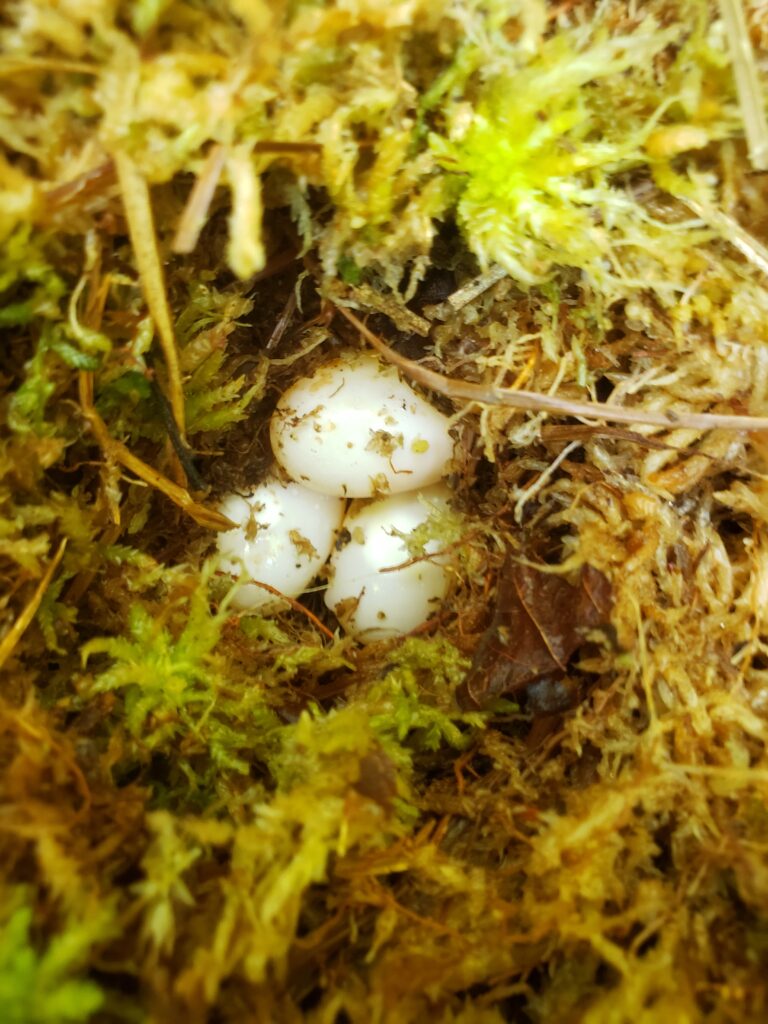
These turtles sometimes behave like Blanding’s turtles, moving a quarter of a mile or more toward uplands to dig their nests in people’s yards, but not always– our senior field conservationist, John Berkholtz, shocked us all several years ago when he found a spotted turtle nest carefully dug into a rotting log with moss atop it in the middle of a vernal pool. With our other turtles, big movements and weight gain are a tell that they’re nearly ready to drop their eggs, and we can focus more of our attention on them.
Another trick we use, a thread bobbin, is possible but extremely labor-intensive– it involves retracing a turtle’s steps for the last 24 hours by following a spooled-out thread, and is twice as frustrating as it sounds, given the pursuit is often through the water. As such, if we can narrow down our targets to just a few turtles at a time, we can give each more intense scrutiny, leading to increased success.
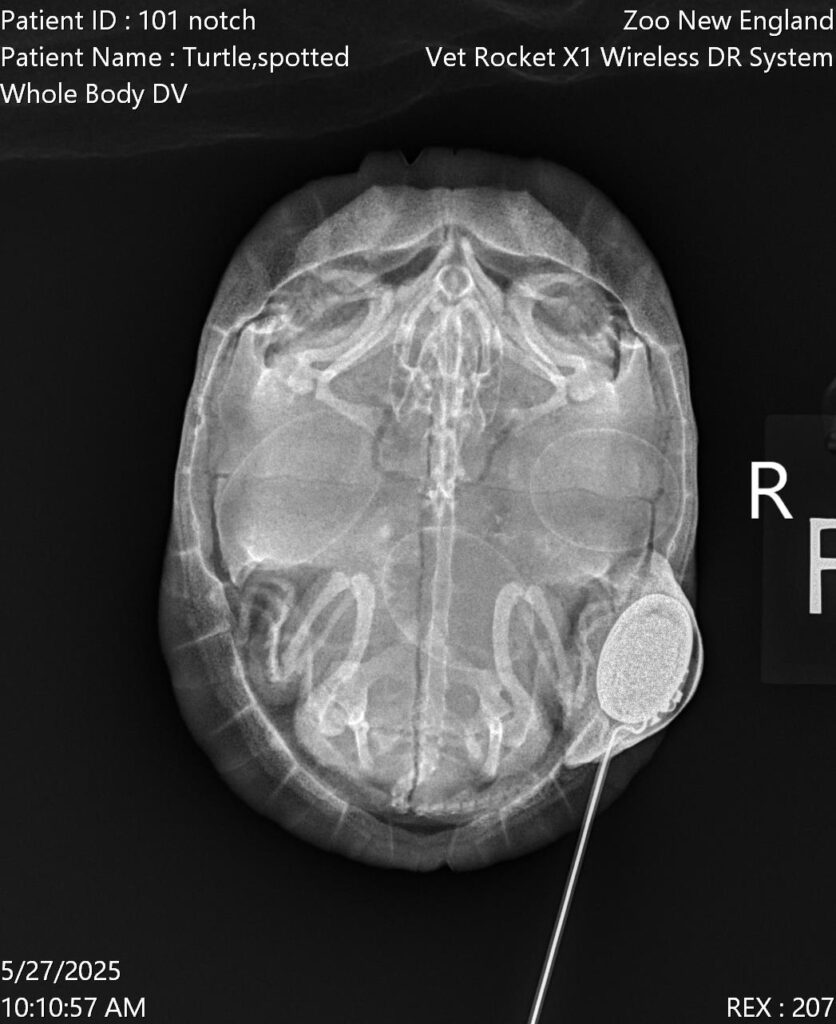
This year, with the support of a Smithsonian contract, we’re finally able to really delve into the specifics of the spotted turtles’ nesting ecology. We have three full-time seasonal folks working on this spotted turtle project and we’re going to cheat by X-raying the turtles to see how “far along” they are in egg development. In 2022 and 2023, we successfully used this tactic on an urban Boston population of spotted turtles, but this was our first time trying it with a mobile unit in the field. This is a huge bonus for the biologists and the turtles, eliminating stress on both.
Tuesday’s effort was a big success. We caught 15 of our 16 targets and brought them all to vet technician Jean Orlando, who deftly handled the mobile machine.
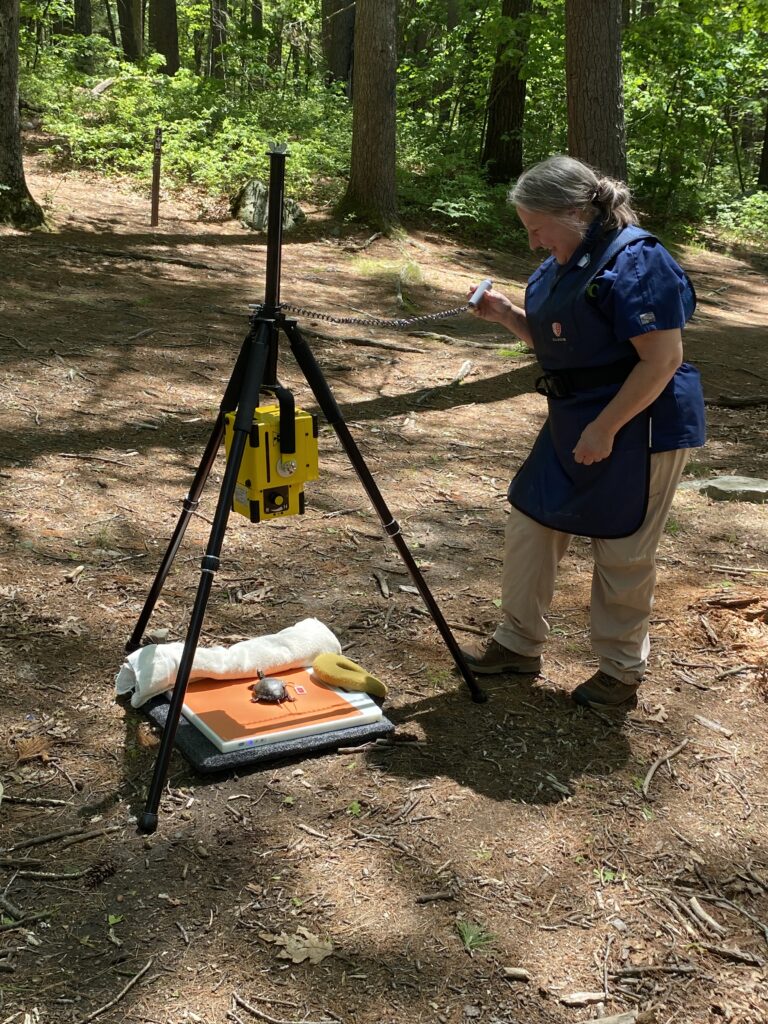
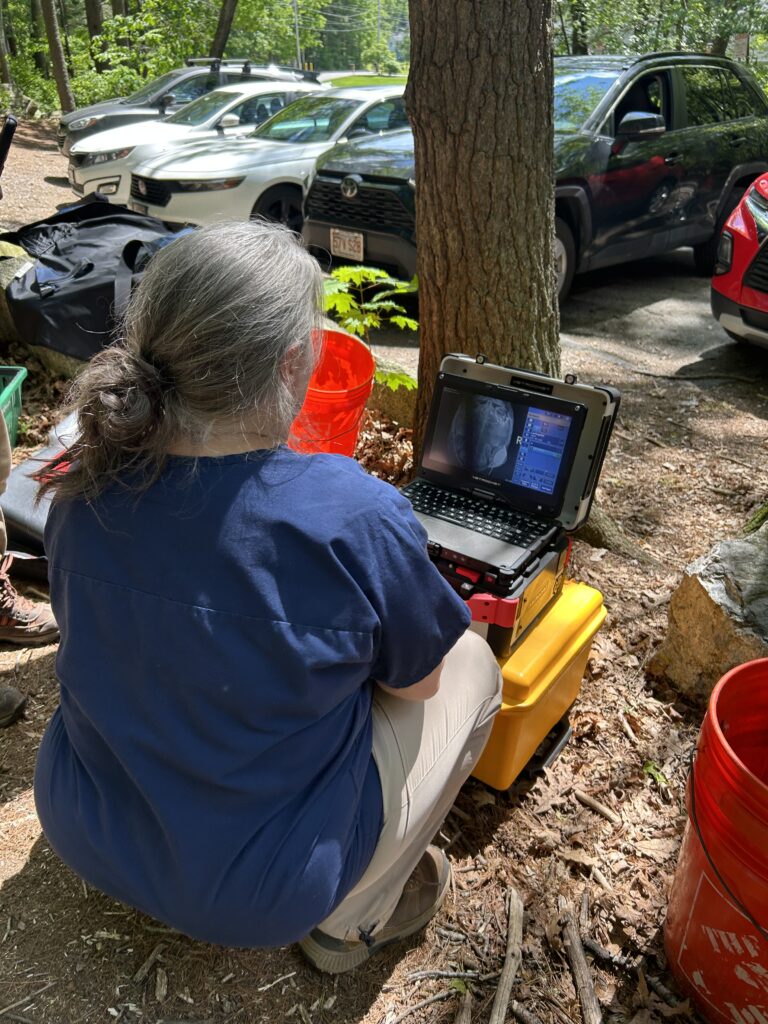
Looking at the screen of the radiographing machine, in the full light of day, two turtles had obvious eggs. For several others, if you craned your neck and squinted your eyes, you could perhaps see the vague outline of future eggs – fully formed, perhaps, but not yet calcified. (All of the photos were reviewed later by Jean and Dr. Abby Needleman in a darkened room on a proper monitor, and the second look did reveal three definitely gravid females!)
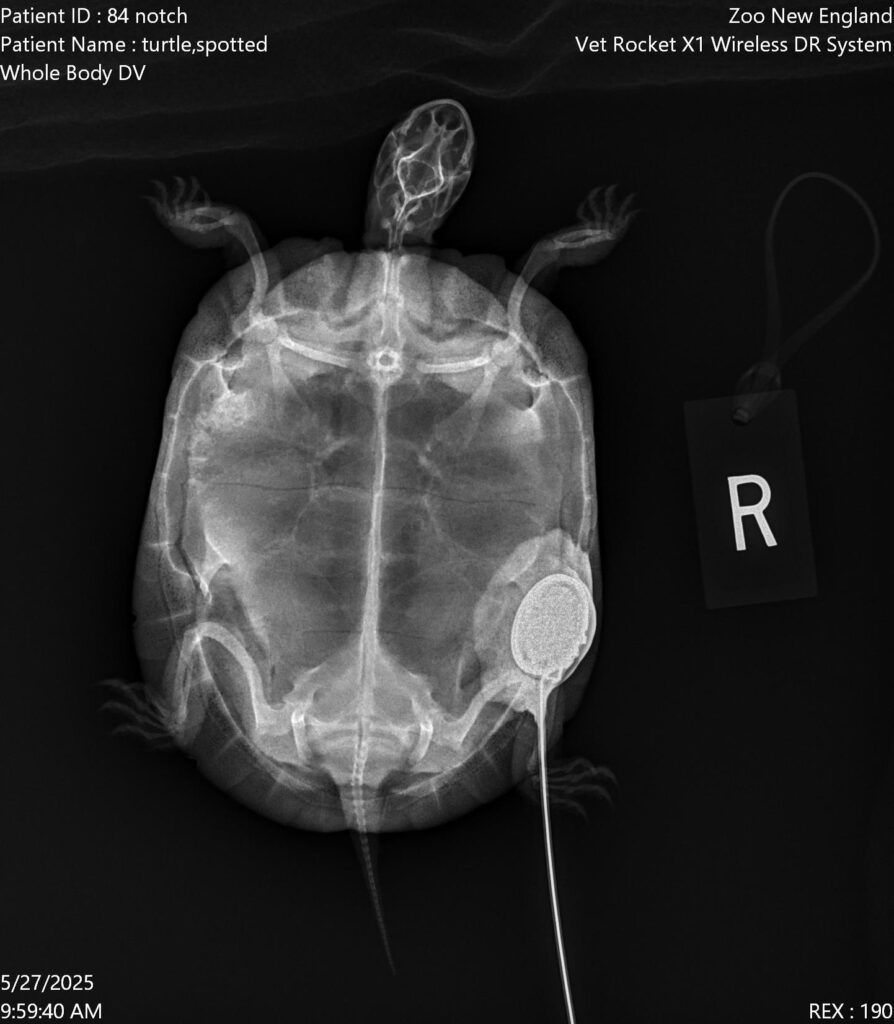
This all-hands effort, involving seven FCD staff, Jean Orlando from ZNE’s Zoo Hospital, and the help and partnership of Lt. Kelly and the whole crew at LDT State Forest, is a brilliant example of collaboration and community. Trailworkers at LDT were delighted to see the spotted turtles – and one of the workers had been out with us with hisecology class at UMass Lowell several years before, with Dr. Ali Hamilton’s lab.
Finding these nests is important– academically and pragmatically. Protecting the nests of rare and threatened species is a large part of our mission, and in this case, we are working in partnership with folks around the US to compare and contrast nesting site selection in this species. Spotted turtles’ ecological range stretches down the Eastern seaboard, and their nesting patterns vary widely as climate and hydrology shift. For this reason, spotted turtles could be harbingers of the impacts of climate change, especially if we can try to get baseline (or early changes) recorded now. We even sent John Berkholtz down to Georgia to share and receive tips and tricks from our southern counterparts at the Orianne Society, which will soon be a blog post of its own.
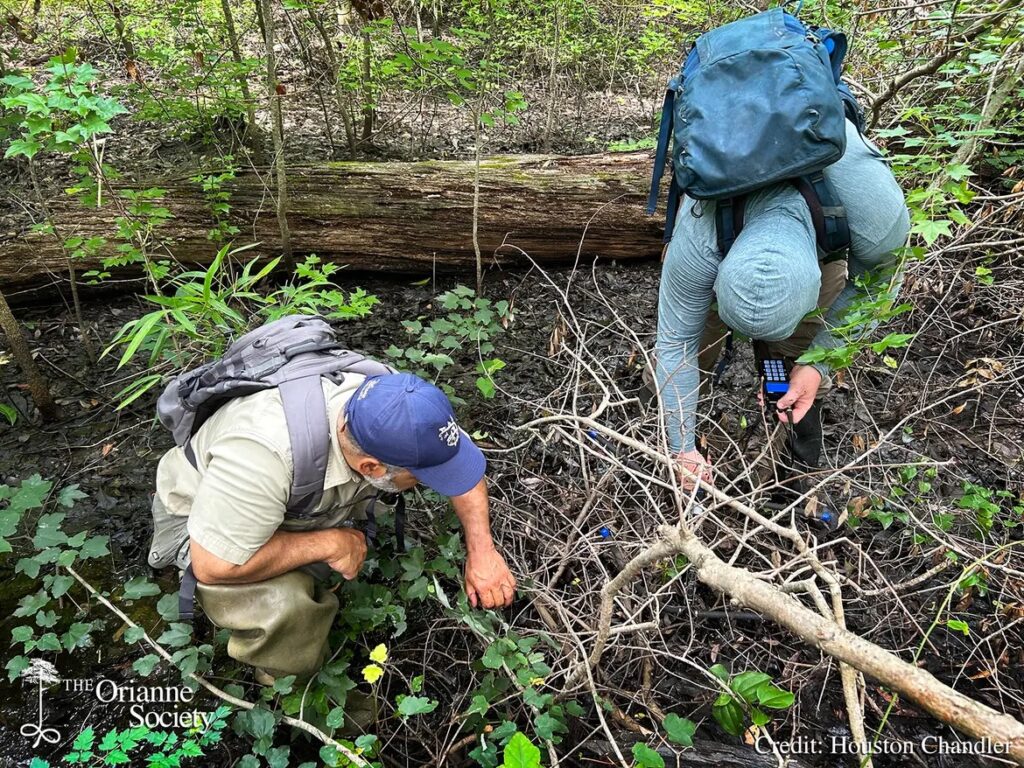
Conservation takes a village, and we’re so grateful for all of our partners and collaborators, and very proud of the work we do. If you want to get involved in the fast-upcoming and nightly nest surveys, join our Conservation Society!
